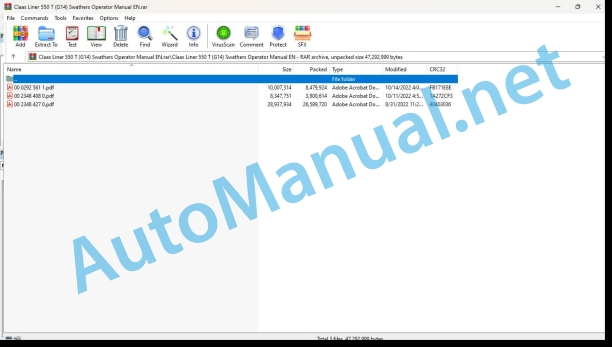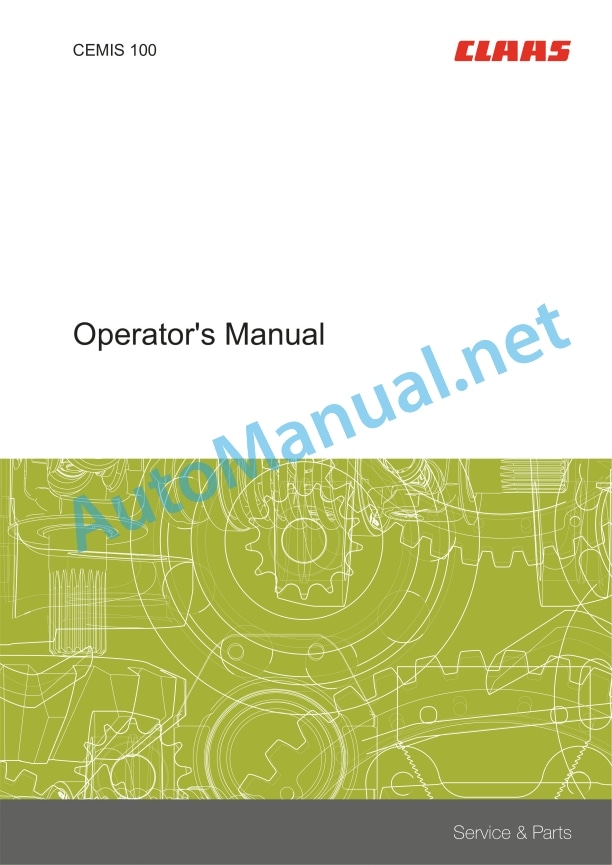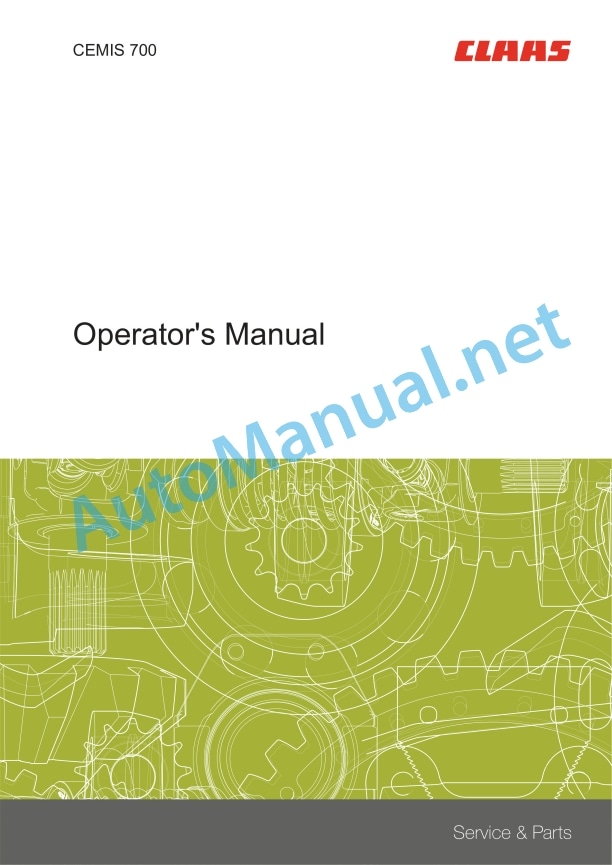Claas Liner 550 T (G14) Swathers Operator Manual EN
$50.00
- Model: Liner 550 T (G14) Swathers
- Type Of Manual: Operator Manual
- Language: EN
- Format: PDF(s)
- Size: 37.1 MB
File List:
00 0292 561 1.pdf
00 2348 408 0.pdf
00 2348 427 0.pdf
00 0292 561 1.pdf:
LINER 550 T
Table of contents
1 To this Operator’s Manual
1.1 Notes on the manual
1.1.1 General instructions
1.1.2 Using the manual
Directions
1.1.3 Validity of manual
1.1.4 Symbols and notes
1.1.5 Technical specifications
2 Safety
2.1 Safety rules
2.1.1 Particularly important
2.1.2 Qualification of drivers and maintenance personnel
2.1.3 Intended use
2.1.4 Reasonably foreseeable misuse
2.1.5 Safety and accident prevention regulations
2.1.6 First aid measures
2.1.7 Danger of injury from hydraulic liquid
2.2 Safety decals on the machine
2.2.1 Safety decals
2.2.2 Position of safety decals
3 Machine description
3.1 Overview and method of operation
3.1.1 Overview
3.1.2 Function
3.2 Optional equipment
3.2.1 Front sensing wheels*
3.2.2 Hydraulically folding safety frames*
3.2.3 Parallelogram drawbar*
3.2.4 Warning signs*
3.2.5 Illuminated warning signs*
3.2.6 Warning signs: Italy*
3.2.7 Legal equipment: France*
3.2.8 SMV triangle*
3.2.9 Lighting adapter for USA*
3.3 Identification plates and identification number
3.3.1 Spare parts and technical questions
3.3.2 Position of identification plate
3.3.3 Position of identification number
3.3.4 Explanation of machine identification plate
3.4 Information on the machine
3.4.1 Decals on the machine
4 Operating and control elements
4.1 Controls
4.1.1 Hydraulic hose
4.1.2 Drawbar
4.1.3 Swathing rotor / safety frame
5 Technical specifications
5.1 LINER 550 T
5.1.1 Dimensions
5.1.2 Weights
5.1.3 Requirements on the tractor
5.1.4 Noise level
5.1.5 Design
5.1.6 Tyre dimensions
5.1.7 Tyre inflation pressure
5.1.8 Lubricants
6 Machine preparation
6.1 Shutting down and securing the machine
6.1.1 Switching off and securing the machine
6.2 Adapting the machine
6.2.1 Universal drive shaft – Checking the length
6.2.2 Adapting the length of the universal drive shaft
6.2.3 Fitting the universal drive shaft to the machine
6.2.4 Adjusting the inclination of the rotor chassis
6.3 Hitching the machine
6.3.1 Hitching the drawbar
6.3.2 Pivoting the jack stand upwards
6.3.3 Pinning the jack stand in a different location
6.3.4 Pinning the jack stand in a different location
6.3.5 Installing the universal drive shaft
6.3.6 Stowing the wheel chocks*
6.3.7 Connecting the hydraulic hose
6.3.8 Connect hydraulic hoses of hydraulically folding safety frames*
6.3.9 Plugging in the lighting cable
6.4 Unhitching the machine
6.4.1 Disconnecting the hydraulic hoses
6.4.2 Disconnect the hydraulic hose of hydraulically folding safety frames*
6.4.3 Disconnecting the lighting cable
6.4.4 Removing the universal drive shaft
6.4.5 Securing the machine against rolling away
6.4.6 Swinging the stand down
6.4.7 Pinning the jack stand in a different location
6.4.8 Pinning the jack stand in a different location
6.4.9 Unhitching the drawbar
6.5 Prepare road travel
6.5.1 General safety precautions
6.5.2 Pushing the windrowing rubber to the inside
6.5.3 Folding the safety frame up
6.5.4 Swinging up hydraulically folding safety frames*
6.5.5 Removing the tine bars
6.5.6 Closing the shut-off tap
6.5.7 Closing the shut-off tap for the hydraulically folding safety frames*
6.6 Prepare field work
6.6.1 Installing the tine bars
6.6.2 Opening the shut-off tap
6.6.3 Opening the shut-off tap for the hydraulically folding safety frames*
6.6.4 Fold safety frame down.
6.6.5 Swing down hydraulically foldable safety frames*
7 Operation
7.1 General safety precautions
7.1.1 Prior to operation
7.2 Driving on the road
7.2.1 Driving on public roads
7.3 Fieldwork settings
7.3.1 Adjusting the swathing rotors
7.3.2 Adjusting the swathing rubber
7.3.3 Setting the working height
7.3.4 Adjusting the sensing wheels*
7.4 Fieldwork
7.4.1 Swathing
7.4.2 Fieldwork
8 Maintenance
8.1 Maintenance Information
8.1.1 General warnings
8.1.2 Electrical system
8.1.3 Protective guards
8.1.4 Spare parts
8.1.5 Unbalance
8.1.6 Compressed air and water
8.1.7 Wheels
8.1.8 Burn prevention
8.1.9 Oils
8.1.10 Fire prevention and explosion prevention
8.1.11 Lines, tubes and hoses
8.2 Overview maintenance intervals
8.2.1 Dealing with maintenance intervals
8.2.2 Before the harvest
8.2.3 After the first 10 operating hours
8.2.4 After the first 50 operating hours
8.2.5 Every 8 operating hours or daily
8.2.6 Every 20 operating hours
8.2.7 Every 50 operating hours
8.2.8 Every 500 operating hours or annually
8.2.9 As needed
8.2.10 After the harvest
8.3 Maintenance operations in general
8.3.1 Clean machine
8.3.2 Preserve the machine
8.3.3 Preventing frost damage
8.3.4 Check the fastening material
8.3.5 Removing swath guard
8.4 Gearbox
8.4.1 Check gearbox tightness
8.4.2 Swathing gearbox: Checking the oil level
8.4.3 Swathing gearbox: Change the oil
8.4.4 Swathing gearbox: Tightening the bolts
8.5 Clutch
8.5.1 Checking the overload clutch
8.5.2 Venting the friction clutch
8.5.3 Checking the friction discs
8.6 Universal drive shaft
8.6.1 Maintaining drive shafts
8.7 Chassis
8.7.1 Checking the tyre air pressure
8.7.2 Rotor chassis: Changing the wheel
8.7.3 Changing the castor guide wheel*
8.7.4 Rotor chassis: Retightening the wheel nuts
8.7.5 Castor guide wheel*: Retightening the wheel nuts
8.8 Hydraulic system
8.8.1 Check the hydraulic hoses
8.9 Drawbar
8.9.1 Check the tension spring
8.10 Rotor
8.10.1 Check the spring brackets
8.10.2 Checking the tines
8.11 Lubrication chart
8.11.1 Lubrication points every 8 operating hours
8.11.2 Lubrication points every 20 operating hours
8.11.3 Lubrication points every 50 operating hours
9 Placing out of operation and disposal
9.1 General Information
9.1.1 Putting out of operation and disposal
10 EC declaration of conformity
10.1 LINER 550 T
10.1.1 EC Declaration of Conformity
11 Technical terms and abbreviations
11.1 Terms and explanations
11.1.1 Abbreviations
11.1.2 Technical terms
00 2348 408 0.pdf:
CEMIS 100
Table of contents
1 Introduction
1.1 General information
1.1.1 Validity of the manual
1.1.2 Information about this Operator’s Manual
1.1.3 Symbols and notes
1.2 Intended use
1.2.1 Intended use
1.2.2 Reasonably foreseeable misuse
2 Safety
2.1 Safety rules
2.1.1 General safety and accident prevention regulations
2.1.2 Interaction between terminal and machine or tractor
2.1.3 Electrocution by electrical system
3 Product description
3.1 Overview and method of operation
3.1.1 Overview of CEMIS 100
3.1.2 Function principle of CEMIS 100
3.2 Identification plates and identification numbers
3.2.1 Spare parts and technical questions
3.2.2 Identification plate of CEMIS 100
4 Operating and display elements
4.1 CEMIS 100
4.1.1 User interface for LINER
4.1.2 User interface for ROLLANT
4.1.3 User interface for UNIWRAP
5 Technical specifications
5.1 CEMIS 100
5.1.1 Specification
6 Operation
6.1 CEMIS 100
6.1.1 Operating the CEMIS 100
6.1.2 Switching CEMIS 100 on
6.1.3 Switching CEMIS 100 off
7 Maintenance
7.1 CEMIS 100
7.1.1 Daily
8 Putting out of operation and disposal
8.1 General information
8.1.1 Removal from service and disposal
9 Technical terms and abbreviations
9.1 Terms and explanations
9.1.1 Technical words
9.1.2 Abbreviations
00 2348 427 0.pdf:
CEMIS 700
Table of contents
1 Introduction
1.1 General information
1.1.1 Validity of the manual
1.1.2 Information about this Operator’s Manual
1.1.3 Symbols and notes
1.2 Intended use
1.2.1 Intended use
1.2.2 Reasonably foreseeable misuse
2 Safety
2.1 Safety rules
2.1.1 General safety and accident prevention regulations
2.1.2 Interaction between terminal and machine or tractor
2.1.3 Electrocution by electrical system
3 Product description
3.1 Overview and method of operation
3.1.1 Overview of CEMIS 700
3.1.2 Function principle of CEMIS 700
3.2 Identification plates and identification numbers
3.2.1 Spare parts and technical questions
3.2.2 Identification plate of CEMIS 700
4 Information on the product
4.1 Software version
5 Operating and display elements
5.1 CEMIS 700
5.1.1 User interface
5.1.2 Terminal program
6 Technical specifications
6.1 CEMIS 700
6.1.1 Specification
7 Operation
7.1 CEMIS 700
7.1.1 Operating the CEMIS 700
7.1.2 Switching CEMIS 700 on
7.1.3 Switching CEMIS 700 off
7.2 Terminal settings
7.2.1 Making settings
Making settings with the rotary button
Making settings with the touch function
7.2.2 Setting the screen lighting
Daytime mode
Nighttime mode
Activating automatic key lighting
7.2.3 Setting the time and date
7.2.4 Displaying diagnosis information
On-board power supply voltage display
Display of CLAAS ISOBUS ECU address and name
7.2.5 Setting the language and display formats
Setting the language
Setting display formats
7.2.6 Setting the volume
7.2.7 Deleting an ISOBUS implement
8 Maintenance
8.1 Maintenance
8.1.1 Daily
9 Putting out of operation and disposal
9.1 General information
9.1.1 Removal from service and disposal
10 Technical terms and abbreviations
10.1 Terms and explanations
10.1.1 Technical words
10.1.2 Abbreviations
John Deere Repair Technical Manual PDF
John Deere Repair Technical Manual PDF
John Deere Repair Technical Manual PDF
John Deere POWERTECH E 4.5 and 6.8 L Diesel Engines TECHNICAL MANUAL 25JAN08
John Deere Repair Technical Manual PDF
John Deere 18-Speed PST Repair Manual Component Technical Manual CTM168 10DEC07
John Deere Repair Technical Manual PDF
John Deere Repair Technical Manual PDF
John Deere Repair Technical Manual PDF
John Deere Transmission Control Unit Component Technical Manual CTM157 15JUL05
John Deere Repair Technical Manual PDF
John Deere Repair Technical Manual PDF
John Deere Repair Technical Manual PDF























